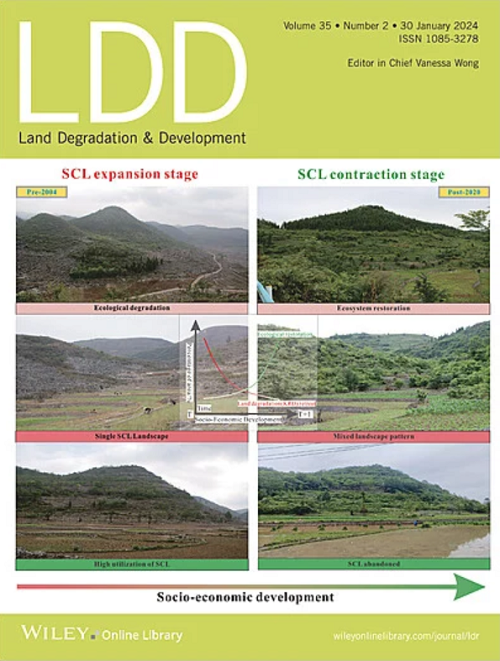长期植被恢复对土壤化学计量的影响?基于黄土高原长期原位监测的实例研究
IF 3.6
2区 农林科学
Q2 ENVIRONMENTAL SCIENCES
引用次数: 0
摘要
土壤养分化学计量学是生态系统功能的基础。然而,长期植被恢复对其动态的影响尚不清楚。本研究采用长期监测的方法,比较了以农田为对照的4种林分类型:农田(CK)、天然次生林(NSF)、刺槐与油松混交林(RPF)、刺槐人工林(RF)和油松人工林(PTF)土壤碳(C)、氮(N)和磷(P)的化学计量特征。重点研究了土壤有机碳(SOC)、全氮(TN)和全磷(TP)及其C:N、C:P和N:P比值。植被恢复30 a期间,土壤有机碳和全氮分别增加了11.65%和7.46%,而总磷则显著减少了11.74%。土壤有机碳和全氮随着自然恢复林(NSF)的增加而显著增加,并在第25年时趋于稳定。在人工恢复(PF、RF、RPF)条件下,土壤有机碳和总氮在13 ~ 15年后恢复到初始值,到25年时趋于稳定。最后,碳氮比没有显著变化,而碳磷比和氮磷比随时间变化而变化,早期波动(0-10年),中期(10-20年)显著增加,后期(20-30年)趋于稳定。气候通过植被因子间接影响有机碳、全氮和总磷。土壤有机碳和全氮受土壤因子和植被因子的直接影响,全磷主要受植被因子的影响。在30年的时间里,随着植被生物量的逐渐积累,养分动态由土壤介导转变为植被介导。长期植被恢复主要通过生物途径增强土壤养分动态,其中树木和草本植物在养分动态和化学计量优化中起关键作用。NSF在提高土壤养分积累和优化土壤化学计量比方面比人工修复更有效。这些结果对制定有效的黄土高原恢复策略具有重要的指导意义。本文章由计算机程序翻译,如有差异,请以英文原文为准。
What Is the Effect of Long‐Term Revegetation on Soil Stoichiometry? Case Study Based on In Situ Long‐Term Monitoring on the Loess Plateau, China
Soil nutrient stoichiometry is fundamental to ecosystem functioning. However, it remains unclear how long‐term vegetation restoration affects its dynamics. This study utilized long‐term monitoring to compare soil carbon (C), nitrogen (N), and phosphorus (P) stoichiometric characteristics with cropland as a control, across four stand types: cropland (CK), natural secondary forest (NSF), Robinia pseudoacacia Pinus tabuliformis R. pseudoacacia P. tabuliformis
求助全文
通过发布文献求助,成功后即可免费获取论文全文。
去求助
来源期刊

Land Degradation & Development
农林科学-环境科学
CiteScore
7.70
自引率
8.50%
发文量
379
审稿时长
5.5 months
期刊介绍:
Land Degradation & Development is an international journal which seeks to promote rational study of the recognition, monitoring, control and rehabilitation of degradation in terrestrial environments. The journal focuses on:
- what land degradation is;
- what causes land degradation;
- the impacts of land degradation
- the scale of land degradation;
- the history, current status or future trends of land degradation;
- avoidance, mitigation and control of land degradation;
- remedial actions to rehabilitate or restore degraded land;
- sustainable land management.
 求助内容:
求助内容: 应助结果提醒方式:
应助结果提醒方式:


